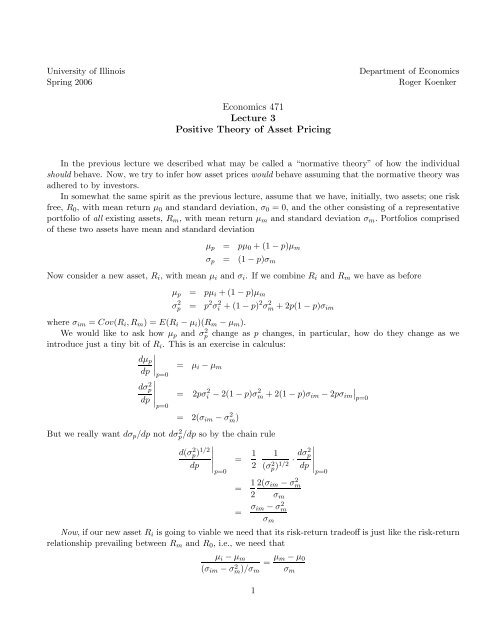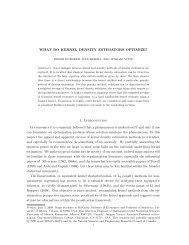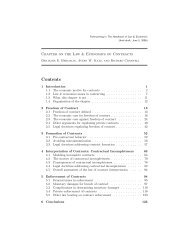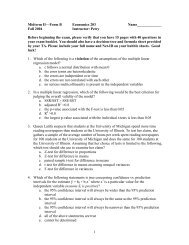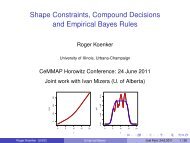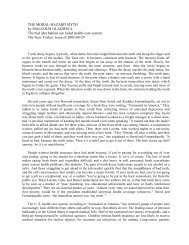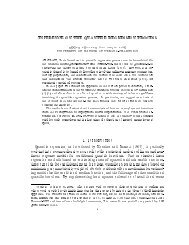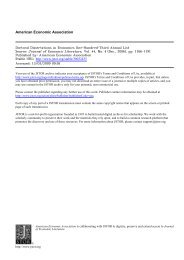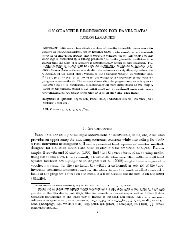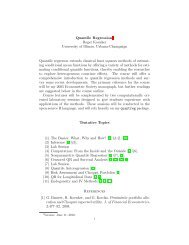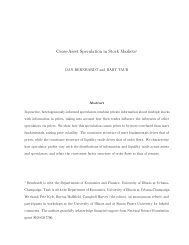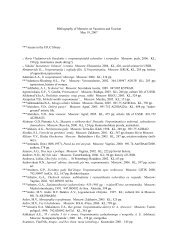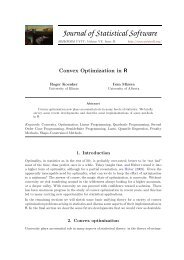Economics 471 Lecture 3 Positive Theory of Asset Pricing
Economics 471 Lecture 3 Positive Theory of Asset Pricing
Economics 471 Lecture 3 Positive Theory of Asset Pricing
You also want an ePaper? Increase the reach of your titles
YUMPU automatically turns print PDFs into web optimized ePapers that Google loves.
University <strong>of</strong> IllinoisSpring 2006Department <strong>of</strong> <strong>Economics</strong>Roger Koenker<strong>Economics</strong> <strong>471</strong><strong>Lecture</strong> 3<strong>Positive</strong> <strong>Theory</strong> <strong>of</strong> <strong>Asset</strong> <strong>Pricing</strong>In the previous lecture we described what may be called a “normative theory” <strong>of</strong> how the individualshould behave. Now, we try to infer how asset prices would behave assuming that the normative theory wasadhered to by investors.In somewhat the same spirit as the previous lecture, assume that we have, initially, two assets; one riskfree, R 0 , with mean return µ 0 and standard deviation, σ 0 = 0, and the other consisting <strong>of</strong> a representativeportfolio <strong>of</strong> all existing assets, R m , with mean return µ m and standard deviation σ m . Portfolios comprised<strong>of</strong> these two assets have mean and standard deviationµ p = pµ 0 + (1 − p)µ mσ p= (1 − p)σ mNow consider a new asset, R i , with mean µ i and σ i . If we combine R i and R m we have as beforeµ p = pµ i + (1 − p)µ mσ 2 p= p 2 σ 2 i + (1 − p) 2 σ 2 m + 2p(1 − p)σ imwhere σ im = Cov(R i ,R m ) = E(R i − µ i )(R m − µ m ).We would like to ask how µ p and σp 2 change as p changes, in particular, how do they change as weintroduce just a tiny bit <strong>of</strong> R i . This is an exercise in calculus:dµ pdpdσ 2 pdp∣ = µ i − µ mp=0= 2pσi 2 − 2(1 − p)σ 2 ∣m + 2(1 − p)σ∣ im − 2pσ ∣p=0 imp=0= 2(σ im − σ 2 m )But we really want dσ p /dp not dσp 2 /dp so by the chain ruled(σp 2)1/2= 1 1dp ∣ 2 (σ 2 · dσ2 p∣p=0p )1/2 dp= 1 2(σ im − σm22 σ m= σ im − σ 2 mσ mNow, if our new asset R i is going to viable we need that its risk-return trade<strong>of</strong>f is just like the risk-returnrelationship prevailing between R m and R 0 , i.e., we need thatµ i − µ m(σ im − σ 2 m)/σ m= µ m − µ 0σ m1∣p=0
orSubtract µ m − µ 0 to both sides to obtain,(σim − σ 2 )mµ i − µ m = (µ m − µ 0 )µ i − µ 0 = (µ m − µ 0 )σ 2 m(σimThis is a fundamental relationship – what does it say? Very simply it says that expected excess returns <strong>of</strong>asset i,µ i − µ 0 , is proportional to the expected excess returns on the market portfolio, µ m − µ 0 , with factor<strong>of</strong> proportionality σ im /σm 2 . The latter factor is a regression coefficient.Suppose we have the classical bivariate linear regression modely i = α + βx i + u iand we estimate α and β by minimizing the sum <strong>of</strong> squared deviations <strong>of</strong> the y i ’s from the estimated line,that is we solve∑min (yi − α − βx i ) 2α,βThe solution isˆβ =ˆα = ȳ − ˆβ¯xσ 2 m∑ (yi − ȳ)(x i − ¯x)∑ (xi − ¯x) 2we can interpret ˆβ as an estimate that simply a ratio <strong>of</strong> estimates <strong>of</strong> the covariance <strong>of</strong> x and y to the estimate<strong>of</strong> the variance <strong>of</strong> x.Looking back at our fundamental CAPM relationship we see that this precisely what our factor σ im /σ 2 mis – the ratio <strong>of</strong> covariance <strong>of</strong> R i and R m to the variance <strong>of</strong> R m . This yields the basic model,)(∗)R it − R 0t = α + β(R mt − R 0t ) + u twhere β now represents σ im /σm 2 . Of course in the model we derived α = 0, so we need to consider this abit further. But the basic message is simple: Expected returns <strong>of</strong> R i given market returns follows a simple,linear regression model.The regression formulation <strong>of</strong> our CAPM relationship yields a variety <strong>of</strong> new insights. The expectedexcess return, µ i − µ 0 , is sometimes called the risk premium <strong>of</strong> asset R i since it measures how much abovethe risk free rate <strong>of</strong> return the expected return on R i needs to be to justify its uncertain return. Similarly,µ m − µ 0 is the risk premium for the market portfolio. The coefficient β can then be viewed as establishinga connection between the risk premium <strong>of</strong> asset, R i , and the risk premium <strong>of</strong> the market as a whole. If β isgreater (less) than one, then R i has a larger (smaller) risk premium than the market risk premium.The regression formulation (∗) allows us to decompose the variance <strong>of</strong> R i into a portion attributed tovariation in the market and a portion independent <strong>of</strong> the market,σ 2 R = β2 σ 2 M + σ2 u .So if we take variance as a measure <strong>of</strong> risk we can view the first component as risk associated with the marketthat can’t be avoided, and the second component as risk that can be avoided by diversification. To seehow the latter works imagine a large number, n, <strong>of</strong> stocks that have random contributions u 1t ,u 2t ,... ,u nt2
independent <strong>of</strong> the market return. For simplicity suppose that we form a portfolio with equal portfolioweights, 1/n, thenV (ū t ) = V ( 1 n∑u it ) = 1 ∑σ2n n 2 iAs long as the σ 2 i are all roughly the same magnitude, say σ 2 i ≤ σ2 0i=1V (ū t ) ≤ σ 2 0/nfor all i, thenso for large n the contribution <strong>of</strong> these components to the portfolio variance is small.On the other hand, the portion <strong>of</strong> the variance associated with the market can’t be diversified away.<strong>Asset</strong>s with β > 1 have variability that magnifies the market variation and they – according to the CAPMtheory – can expect to earn a large risk premium to compensate. <strong>Asset</strong>s with β < 1 vary less violently thanthe market as a whole and therefore earn less than the market rate <strong>of</strong> return.What if β ≤ 0? If β = 0, the model predicts that ER i = µ 0 , that is that the asset should earn the riskfree rate <strong>of</strong> return; this is true because in this case there is only diversifiable risk. When β < 0 the situationis even more extreme: when the market goes up the expectation is that such assets go down and vice-versa.This makes them ideal diversification investments: when the market declines they tend to s<strong>of</strong>ten the blow.Unfortunately such assets are hard to find. In some periods gold has shown some tendency to exhibit anegative β. This is explored in the last part <strong>of</strong> the first problem set.Finally, a word about α in the regression model (∗). As derived, α should take the value zero. If whenwe estimate the model we see an ˆα > 0 it means that over the estimation period the asset in question hadreturns that exceeded that predicted by the CAPM, and likewise if ˆα < 0 its performance was worse thanpredicted. Of course, when estimating such models from historical data, ˆα’s are always non zero, what ismore important is to ask: how strong is the evidence that α ≠ 0. Typically this evidence is very weak.3


